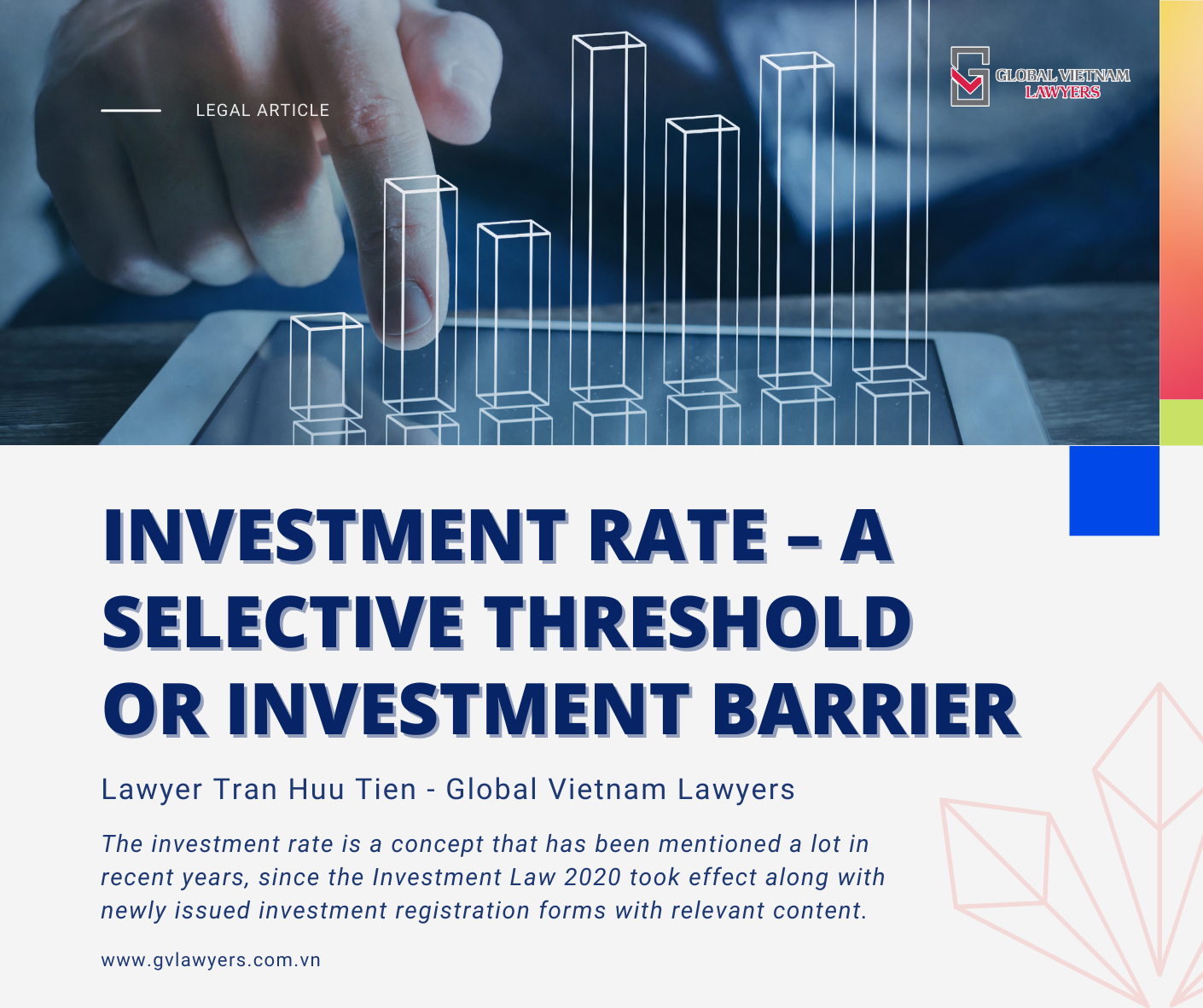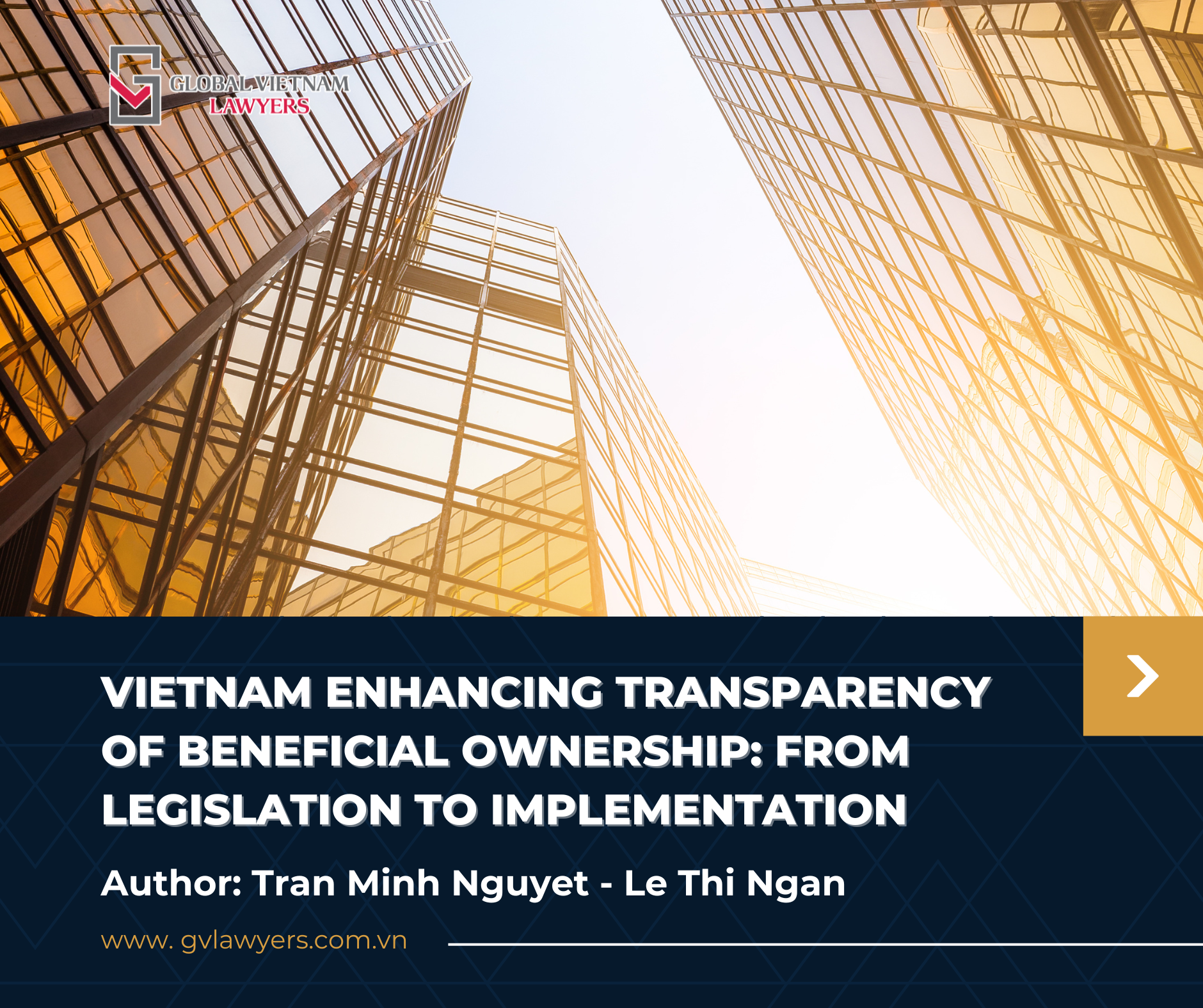GV Lawyers would like to introduce our valued readers to an article by Lawyer Tran Huu Tien titled “Investment rate – A selective threshold or investment barrier” published in The Saigon Times, No.35-2024 (1.759) on August 29, 2024.
***
The investment rate is a concept that has been mentioned a lot in recent years, since the Investment Law 2020 took effect along with newly issued investment registration forms with relevant content. This concept initially seems quite unfamiliar, but the practice of investment registration shows that the investment rate is more than just a concept “staying on paper only” but has a special meaning for investment management agencies upon reviewing registration dossiers. On the contrary, many investors also encounter a lot of confusion and questions in their efforts to meet the requirements for investment rate.
What is the investment rate?
Many investors, including foreign investors who do not have much experience in investment activities in Vietnam, are confused about the investment rate, because the specialized investment agencies as well as the current specialized investment legal documents have only mentioned this concept without providing a basic and complete definition.
Enterprises with many years of expertise in domestic construction are probably more fortunate because they are able to access a similar concept that used to be rolled out before (investment capital rate), so they do not consider this something too new. In fact, the content of the investment capital rate has appeared sporadically in a number of legal documents on construction investment cost management, but it was not until Decree 10/2021/ND-CP on construction investment cost management, effective from February 9, 2021 (Decree 10/2021/ND-CP), that the legal concept of investment capital rate officially appeared (in Article 25).
Referring to the aforesaid provisions pending a clear definition and specific guidances from state agencies on investment rate in investment activities, we can now understand that the investment rate is a summary of expenses (possibly excluding certain items) that investors will need to invest for each specific unit in their investment project, commonly square meters or long meters, depending on the scale and characteristics of each project. The investment rate is jokingly called “investment unit price” by many people from here.
Legal role of the investment rate
From a legal perspective, it can be understood that investors will need to rely on the applied investment rate to estimate the (minimum) construction investment cost of the project upon conducting a pre-feasibility study, if applicable (please refer to Article 4 of Decree 10/2021/ND-CP). Upon calculating the total construction investment, the investment rate can also serve as a basis for determination (pursuant to Article 134.3 of the Construction Law 2014).
In addition, Decision 510/QD-BXD of the Ministry of Construction dated May 19, 2023 also provides the following guidance: “The investment rate announced in this Decision is one of the bases for determining the preliminary total construction investment, total construction investment, determining and managing construction investment costs at the project preparation stage.”
Thus, if we temporarily consider “investment rate” to be the investment capital rate applied similarly to investment projects that are not construction investment projects, the investment rate will be one of the targets that investors need to pay attention to and consider upon deciding on the (minimum) investment value for the project, as well as for investors to first determine the capacity and ability to implement the investment project.
Where to refer to the investment rate?
As a general rule, state agencies will issue and provide guidance on investment rate. Specifically in the field of construction investment, pursuant to Articles 26 and 40 of Decree 10/2021/ND-CP and Article 11 of Circular 11/2021/TT-BXD dated August 31, 2021 of the Ministry of Construction guiding a number of contents on determining and managing construction investment costs, the Ministry of Construction will be held accountable for developing and announcing the periodic construction investment rate before January 31 of each year applicable to projects subject to Decree 10/2021/ND-CP. To date, the construction investment rate has been most recently updated by the Ministry of Construction in Decision 510/QD-BXD, towards applying to eight specific geographical areas, with clear and complete explanations and application guidances.
For investment sectors that do not involve construction, there are not many legal documents regulating specific investment rate. In practice, working with a number of specialized investment management agencies shows that these agencies will have guidelines on necessary investment rates or investment levels applicable to each area, depending on each specific time. Accordingly, as general experience in case of impossibility to determine the investment rate applicable in the expected area, investors should contact local investment management agency in advance to receive specific guidances on the investment rate according to local investment policies (if applicable), as well as suggestions upon considering the total investment capital of the project (if possible).
Impact of the investment rate in terms of investment activities and practice
In previous stages, pursuant to Circular 16/2015/TT-BKHĐT in 2015 and previously Decision 1088/QD-BKH in 2006 (both of which have expired), investors were not required to present investment rate in their investment project registration dossiers at the investment management agency. This requirement has only appeared since the Investment Law 2020 is applied, which stipulates conditions on investment rate per land area upon considering grant of investment registration certificates (Article 38.2 of the Investment Law 2020). This content is specified in the sample documents proposing implementation of investment projects issued together with Circular 03/2021/TT-BKHĐT dated April 9, 2021 of the Ministry of Planning and Investment that investors currently need to submit to obtain an investment license for a new project in the spirit of the Investment Law 2020.
The foregoing regulations lead to the fact that upon reviewing investment registration dossiers, the investment registration agency, in addition to other factors such as the right to use the location, planning conditions for market access, business lines, etc., will also check and evaluate whether the proposed investment capital level for the project is consistent with the investment rate applicable to the area or not (if applicable) (Article 38 of the Investment Law 2020). There have been cases where investors have been instructed to consider increasing the investment capital level to match the required investment capital targets applicable to the area. Many application files are even rejected because the investment capital level is not appropriate.
In general, with the lawmaker setting up a mechanism to review investment rate upon licensing new projects, investors will need to go through an additional threshold for the project to be officially recognized by the competent authority. This can bring a uniform appearance to investment projects in the same area, when the investment capital in these projects is required to reach a certain level that the state management agency considers appropriate for that area. If, in parallel with the investment level prescribed by law, investors can ensure the respective business capacity, it will be a very positive development in implementing investment encouragement policy.
However, in another aspect, the investment capital of the project is not something that investors can proactively control in all cases. In addition to the investor’s wishes, investment capital basically depends on many objective and subjective factors such as business plan, financial capacity, cost management, etc. In fact, many investors feel quite confused when they decide to choose an area to implement an investment project with the planned capital level, but upon conducting licensing procedures or consulting with local state agencies, they are told that their registered capital level is not appropriate for approval even though the business line does not require a minimum legal capital level. It must be understood that the actual total investment of the project includes not only construction investment costs, but also many other items such as labor costs, working capital, machinery and equipment, premises rent, etc. Thus, the final figure may be much higher than the investor’s initial estimate.
This situation raises the following options: (1) Investors are forced to arrange an investment capital level that matches the requirement for investment rate, or (2) have to choose another area, or (3) even have to abandon the investment plan. Optimistically, this will help filter out unserious investors or small investors who do not match local development planning. However, this can also be considered one of the biggest challenges that prevent investors from implementing their investment plans in Vietnam, leaving investment capital stagnant. Another question is also raised: what if a project has a large positive impact on the socio-economic landscape (for example, developing modern technology and techniques, great potential for social contributions, etc.), but only with a modest initial capital flow and does not meet the applied investment rate target?
The overview on investment rate as aforesaid shows that this can be considered one of the decisive factors for attracting or hindering investment for investors (including foreign investors), whereby affecting the broader picture of the national investment attraction policy and Vietnam’s international commitments on economic opening from time to time. Against the backdrop of the world economy and Vietnam facing many challenges and woes, as well as current capital mobilization of enterprises being of no easygoing story, a certainty is that the specific investment rate applied in the coming time will need to be considered and appropriately decided by competent state agencies to ensure meeting the investment and development goals set out by the National Assembly and the Government.
On the part of the investor, finding out information about the investment rate that can apply to their investment project is an extremely necessary action for the investor and the consulting unit (if any) before deciding on a matching investment and business plan to avoid delays or escape from late, unexpected changes.









